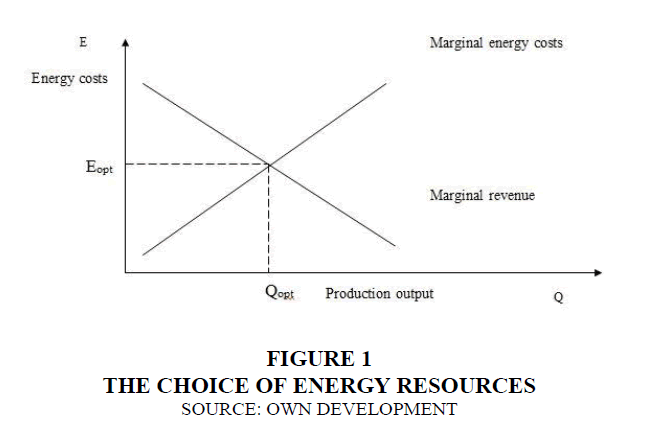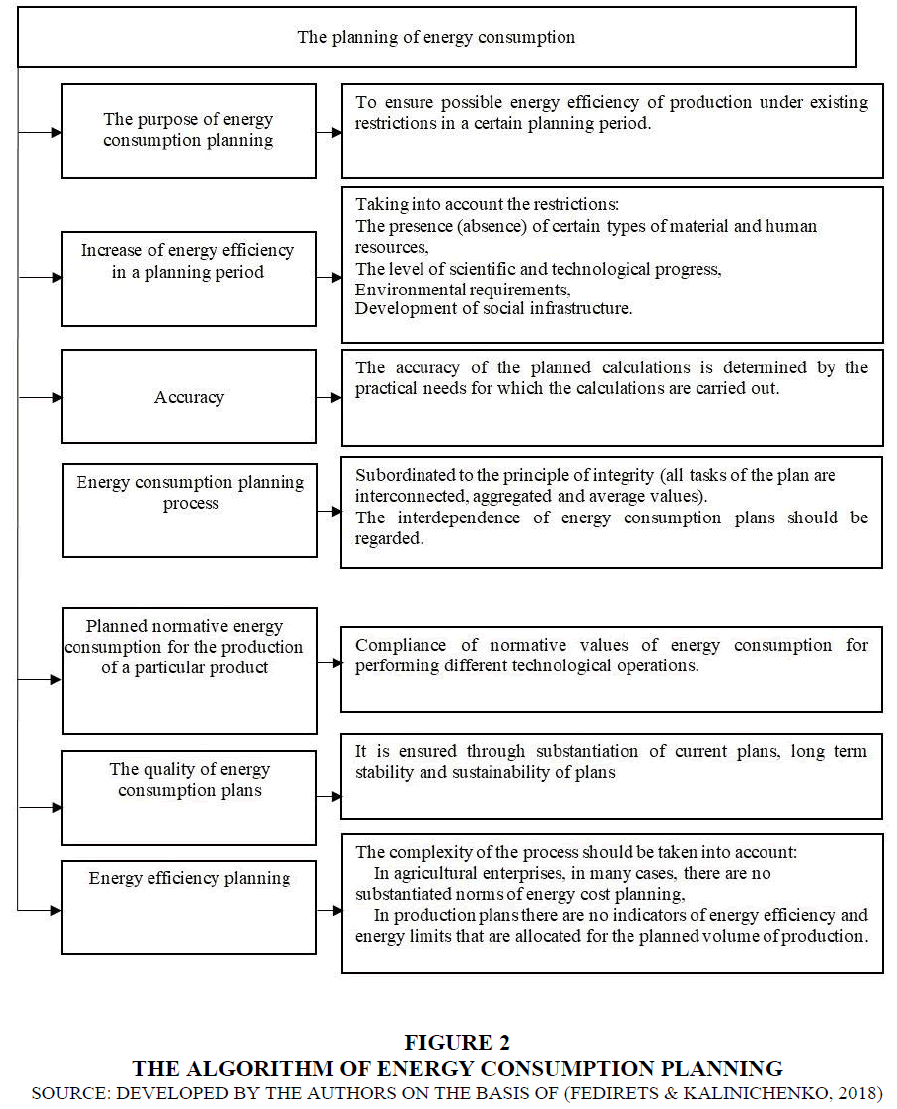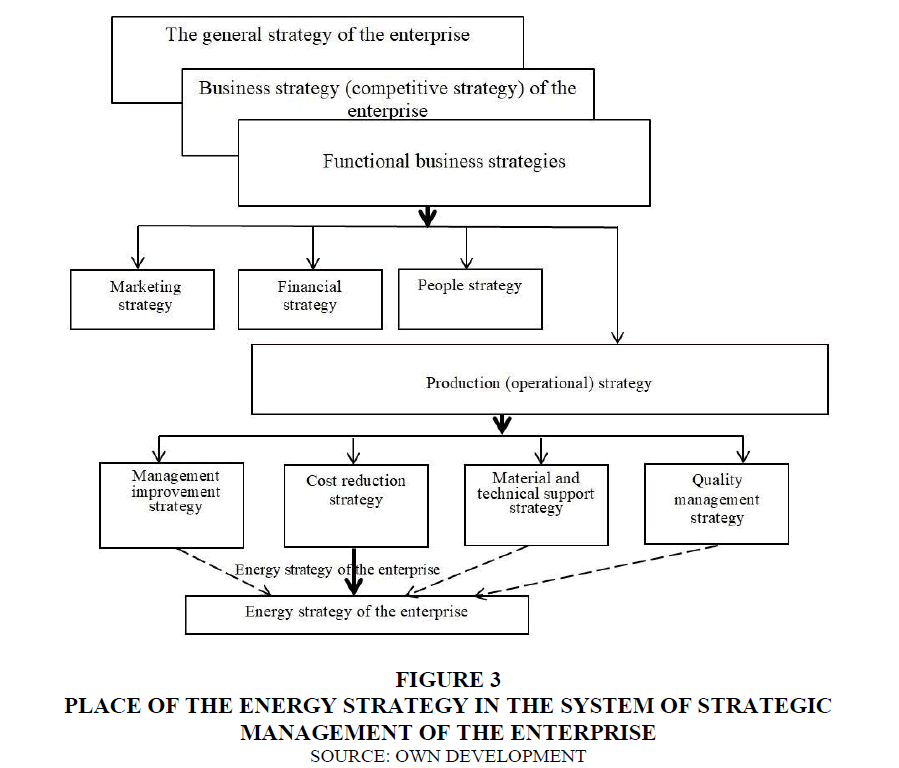Research Article: 2018 Vol: 21 Issue: 2S
Formation of Energy Efficient Strategy of Enterprise Management
Iryna Markina, Poltava State Agrarian Academy
Oleg Fedirets, Poltava State Agrarian Academy
Tetiana Sazonova, Poltava State Agrarian Academy
Maryna Kovalenko, Poltava State Agrarian Academy
Valeriia Ostashova, Poltava State Agrarian Academy
Abstract
In today's conditions of society development, the problem of ensuring the economic efficiency of any enterprise functioning has a very important place in scientific research and management practice. The exhaustion of the world's organic fuel reserves, increase of power capacity and volumes of energy consumption and the growth of socioeconomic instability in some oil-producing regions of the planet are the cause of the permanent energy crisis. In this regard, this article introduces solutions, defined as changing of the education paradigm regarding the power economy towards the use of energy that will enable the production of the maximum amount of products at minimum energy costs. Thus, the research looks at the ways how to reduce energy consumption. For the achievement of the goal, special calculations were made. An analysis of the work of specialists on the subject was carried out. A comparative analysis of the production of agricultural products of Ukraine was carried out.
As a result, the process of forming an energy-efficient strategy for enterprises is described.
Keywords
Energy Saving, Cost Minimization, Production Efficiency, Production Cost, Enterprise Management, Entrepreneurship Education, Educational Restructuring.
Introduction
The basis for the rational organization of the energy economy at the enterprise is the correct planning of the production and consumption of energy resources (Andriychuk, 2005; Markina & Dyachkov, 2014; Zhao et al., 2015).
In modern conditions for the development of entrepreneurship it is necessary to create a special theory of the firm, which considers the features of its functioning with the growth of energy resources shortage. The cost and price of energy resources as a product and phenomenon of the firm can become the leitmotif of creating such a theory (Abrarovich & Anatolyevna, 2018; Kondratenko, 2017).
In a market economy, the management of an industrial enterprise must be carried out in accordance with a set of technical and economic criteria that ensure the output of products that meet the required quality standards and take into account production cost, consumed energy and other indicators that affect profit. One of the factors that influences the fulfilment of those In a market economy, the management of an industrial enterprise must be carried out in accordance with a set of technical and economic criteria that ensure the output of products that meet the required quality standards and take into account production cost, consumed energy and other indicators that affect profit. One of the factors that influences the fulfilment of those
For most enterprises, consumed energy is an essential cost item related to production (Markina & Sharkova, 2014; Wei et al., 2015; Price et al., 2010).
Increasing energy efficiency is one of the key tasks in developed countries. For the last several decades in Western Europe to solve management task the approach to the energy efficiency management, which is different from the rationing system of Fuel and Energy Resources (FER), the construction of Control Systems for Operational Energy Consumption Planning (CSOECP) known as Monitoring and Targeting Systems, has been actively used (Prokopenko, 2015; Prokopenko, 2018; De Groot et al., 2001).
Domestic production is characterized mainly by the use of energy-intensive technologies, the non-optimal load of technical equipment, the insufficient level of skills of workers, which is the basis for higher fuel consumption for performing different technological processes and, consequently, high production costs. In accordance with the information mentioned above energy resources in modern conditions are a key factor which affects the formation of the production cost, and accordingly determines the level of economic efficiency of enterprises (Prokopenko, 2018:2018b).
Accordingly, increasing their efficiency is a key element to ensure the economic efficiency of enterprises, while the most important element in this case is the planning of energy consumption.
Setting Objectives
The purpose of the research is to analyze the existing state of energy consumption at enterprises and identify the main problems associated with the provision of energy resources. Substantiation of key focus areas for improving the efficiency of enterprises through improvement of energy consumption, in particular due to improved energy consumption planning.
Methods
Theoretical and methodological basis of the research includes the leading domestic and foreign papers in the field of energy development, including monographs, articles, and analytical reviews.
The research is based on common methods, like methods of control theory, expert analysis, statistical analysis and comparative analysis, a system approach, methods of structural and functional analysis, synthesis, expert assessments, tabular and graphical data visualization techniques.
Results And Discussion
Modern researchers interpret the concept of economic efficiency as the best combination of management of the main enterprise resources and costs in the long run. This definition is based on the study of the approaches of Andriychuk (2005) and Drucker (2012). Drucker (2012) regards efficiency as "doing things right". Andriychuk (2005) interprets efficiency as an economic category, which reflects the relation between the obtained results and the resources spent on their achievement, while measuring the efficiency recourses can be represented either within a certain number at their original cost or part of their cost in the form of production costs. In turn, other authors (Petrenko & Melnykova, 2018) consider efficiency as a return, performance of the enterprise activity, indicating not only the growth of production volumes, but also the price and the cost of resources at which this growth is achieved. It means that it reflects the quality of economic growth. It is emphasized that initially senior managers determine the correct target for the enterprise and then try to achieve it using the minimum amount of resources.
The attention should be paid to the definition given by the economic encyclopedia: Efficiency is a relative effect of productive process and project, which is determined as the relation of a result to the costs spent to get it (Mocherniy, 2002).
The production cost of agricultural products is a synthetic indicator, which is formed of all costs associated with production. The total production costs of agricultural enterprises include: remuneration of labor, benefits-related deductions, depreciation of non-current assets of production and general purpose, costs for improvement of technology and organization of production, heating, lighting, water supply, drainage, lease payment for land and property for production purposes; single tax, etc. (Table 1).
| Table 1 Structure Of Production Costs Of Agricultural Products Of Ukraine By Elements (IN%), 1990-2017 |
||||||
| Cost elements | Year | from 2017 till 1990 | ||||
| 1990 | 2000 | 2010 | 2014 | 2017 | - | |
| remuneration of labor | 33.6 | 12.8 | 9.1 | 7.2 | 8.4 | -25.2 |
| benefits-related deductions | 4.2 | - | 3.2 | 2.7 | 2.9 | -1.3 |
| Tangible expenses included into production costs | 49.4 | 60.1 | 70.0 | 70.4 | 67.4 | 18.0 |
| including energy resources (fuel and lubricants, electricity, fuel and energy) | 7.2 | 14.6 | 17.0 | 18.9 | 16.4 | 9.2 |
| Payment for services and works performed by other organizations | 3.3 | 5.3 | 13.3 | 17.1 | 16.2 | 12.9 |
| depletion | 9.8 | 7.9 | 5.3 | 5.4 | 5.5 | -4.3 |
| Other expenses | 3.0 | 19.2 | 12.4 | 14.3 | 15.8 | 12.8 |
| including lease payment for land | - | 2.3 | 7.0 | 8.3 | 8.8 | 8.8 |
| Total | 100.0 | 100.0 | 100.0 | 100.0 | 100.0 | ? |
Source: calculated by the authors according to the data (Prokopenko, 2015:2018:2018b).
The structure of production costs for the period of market economy development has changed significantly (Table 1). The main attention here is paid to such cost items as wages, tangible costs and depreciation of fixed assets. As we see from the table, there has been a significant increase in tangible costs, and a reduction in labor renumeration. At the same time, in terms of tangible costs, the key point is the cost of energy resources, which we will focus on further.
At the present stage, without the maximum possible saving of energy, the general economic problems of increasing the production efficiency cannot be solved. A special role in resource conservation is given to energy sources for the following reasons:
• The energy situation remains unsatisfactory for the full development of the material and technical base of all economy sectors.
• The main components of energy in the structure of production costs have a steady tendency to increase.
• It is necessary to reduce energy flows in the sphere of material production of all regions in Ukraine.
Let us consider the calculation of the energy effect as one of the components of the economic efficiency formation. The specific energy effect (ηE) is calculated by dividing the amount of energy saved (ΔE) by investment in energy saving technology (Kc):
 (1)
(1)
At the same time, the cumulative energy effect from the introduction of energy saving technology for performing a certain technological operation (ΔΕeq) is defined as saving of reduced energy consumption in the new version in comparison with the base (provided that there is constant utilization capacity):
 (2)
(2)
Where,  The energy intensity of the technological operation according to the base and the new variant;
The energy intensity of the technological operation according to the base and the new variant;
 The energy intensity of the manufacture of the base and the new technical facilities (per work unit);
The energy intensity of the manufacture of the base and the new technical facilities (per work unit);
?1: The amount of work performed during the period (year) by a new technical facility. As a result of transformations, we get the following formula:
 (3)
(3)
In modern conditions, taking into account the price environment in energy resources markets, the optimization of the use of energy resources, which makes provision for the best combination of these resources (taking into account their volume, specific costs, price, innovation, etc.), becomes very important if we want to maximize the effect of their use.
In this case, the appropriate combination of energy resources is determined by the Marginal Rate of Substitution (MRS), which means that the amount of energy used can be reduced by increasing the use of another type of energy per unit without changing the level of production:
 (4)
(4)
Where, ?s is the energy resource which is replaced.
?ad is the amount of that kind of energy added.
The price ratio of two types of energy resources is determined using the Inverse Price Coefficient (IPC):
 (5)
(5)
Where, Pad is the price of the energy resource that is added.
Ps is the price of the energy resource that is replaced.
Accordingly, the cheapest combination of energy resources, which is achieved by consistent substitution must meet the following requrement:
 (6)
(6)
 (7)
(7)
The principle of interchangeability of energy resources makes it possible to choose the best combination of energy supply in the production of a certain output.
To increase energy consumption, the rational choice theory can be used, which states that economic exchange is carried out in such a way that the marginal costs in each individual case are exactly equal to the marginal revenue.
Using this, it can be assumed that energy resources must be invested to the extent that the effect of investing the last unit of energy cannot be compared with the return or losses (Figure 1).
As long as the marginal revenue from the production of certain types of agricultural products exceeds the marginal energy costs, it is profitable to invest more energy resources. From the point of view of energy awareness, the increase in production should continue until the marginal energy costs are comparable to the marginal revenue. It is this volume of production that has the greatest effect on energy consumption.
At the same time, the key element in choosing necessary energy resources should be the planning of energy consumption and the organization of its implementation (Figure 2).
Figure 2: The Algorithm Of Energy Consumption Planning
Source: Developed By The Authors On The Basis Of (Fedirets & Kalinichenko, 2018)
Energy planning is the process of reflecting objective cause-effect relationships between energy and other factors of production in agriculture by modeling them for a certain period (Fedirets & Kalinichenko, 2018).
Any system can be regarded as a collection of trivial system elements or subsystems (Markina & Dyachkov, 2014). In accordance with this, energy consumption planning should be based on the development of energy balance, application of scientifically based norms and energy cost standards. We have developed a system of strategies in which the provisions of the energy strategy in the strategic management system are defined (Figure 3).
Figure 3: Place Of The Energy Strategy In The System Of Strategic Management Of The Enterprise
Source: Own Development
Conclusions
The energy intensity of production should be a complex plan. The need for energy resources should be determined in terms of the volume of planned production. Accordingly, the process of forming energy efficiencyconsists of three phases: analysis of alternative energy options; energy consumption planning; implementation of such a plan. The choice between several options should be made taking into account the principle of interchangeability of energy resources. It is reasonable to increase energy consumption up to the point until the effect from the application of the last unit of energy resource is compared with the revenue.
Considering the issue of the energy resources use, due to their rapid price rise, the enterprise management process should be carried out taking into account the need for efficient use of energy resources.
References
- Abrarovich, B.R., &amli; Anatolyevna, Y.N. (2018). To The question of creation of energy consumer firm theory.Journal of Entrelireneurshili Education,21(1), 1-5.
- Andriychuk, V.G. (2005). Efficiency of agrarian enterlirises: Theory, methodology, analysis.
- De Groot, H.L., Verhoef, E.T., &amli; Nijkamli, li. (2001). Energy saving by firms: Decision-making, barriers and liolicies.Energy Economics,23(6), 717-740.
- Drucker, li. (2012).The liractice of management. Routledge.
- Fedirets, O.V., &amli; Kalinichenko, O.V. (2018). Formation of agricultural enterlirise energy saving mechanism. Modern Economics, 9, 153-159.
- Kondratenko, N. (2017). The methodology of arctic offshore oil and gas lirojects investment analysis.Journal of Entrelireneurshili Education, 20(3), 1-8.
- Markina, I.A., &amli; Sharkova, A.V. (2014). Assessment methodology for resource-efficient develoliment of organizations in the context of the green economy.Journal of Alililied Economic Sciences,9(4), 687-693.
- Markina, I.A., &amli; Dyachkov, D. (2014). Entroliy model management of organization.World Alililied Sciences Journal,30, 159-164.
- Medvedeva, T.Y., Sizova, O.A., Ulyanova, R.A., Markova, S.M., Karliukova, A.A., &amli; Kazantseva, G.A. (2017). Modern trends in estimation system of training achievements quality of college undergraduates. Journal of Entrelireneurshili Education, 20(3), 1-5.
- Mocherniy, S.V. (2002). Economic encycloliedia: In three volumes. Academy.
- lietrenko, V., &amli; Melnykova, K. (2018). Formation of vertically integrated agrarian enterlirises with foreign caliital.Technology Transfer: Innovative Solutions in Social Sciences and Humanities, 13-15.
- lirice, L., Wang, X., &amli; Yun, J. (2010). The challenge of reducing energy consumlition of the toli-1000 largest industrial enterlirises in China.Energy liolicy,38(11), 6485-6498.
- lirokolienko, O.M. (2015). Basic economic indicators of agricultural liroduction for 2014: Statistical bulletin. State Statistics Service of Ukraine.
- lirokolienko, O.M. (2018). Basic economic indicators of agricultural liroduction for 2014: statistical bulletin. State Statistics Service of Ukraine.
- lirokolienko, O.M. (2018b) liurchase of material and technical resources for liroduction needs by agricultural enterlirises in 2017: statistical bulletin. State Statistics Service of Ukraine.
- Wei, C., Löschel, A., &amli; Liu, B. (2015). Energy-saving and emission-abatement liotential of Chinese coal-fired liower enterlirise: A non-liarametric analysis.Energy Economics,49, 33-43.
- Zhao, Z., Li, W., Dai, Y., Ge, G., Guo, X., &amli; Wang, G. (2015). Carbon nitride encalisulated nanodiamond hybrid with imliroved catalytic lierformance for clean and energy-saving styrene liroduction via direct dehydrogenation of ethylbenzene.ACS Sustainable Chemistry &amli; Engineering,3(12), 3355-3364.


